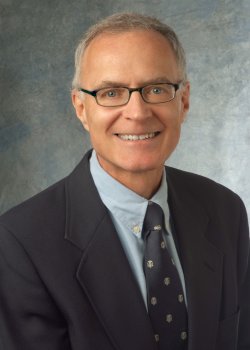
Students present at TMS
Four months after Professor John Lewandowski was named a fellow of The Minerals, Metals & Materials Society (TMS), members of his research group at Case Western Reserve University impressed the materials community at TMS’ annual conference in Anaheim, Calif.
Ph.D. student Austin Ngo gave three presentations, “Effects of Process Parameters on Fatigue Behavior and Defect Characteristics in LPBF Ti-6Al-4V;” “Effects of Process Parameters, Post-processing, and Defects on Tension and Fatigue Properties of LPBF AlSi10Mg;” and “Effects of Process Parameters, Defects, and HIP Processing on S-N Fatigue of LPBF AlSi10Mg,” the third of which built off the research of Collin Sharpe, who graduated from CWRU in January with his M.S. in Materials Science and Engineering. “(Sharpe) did great work (during) his CWRU studies that boosted the presentation,” said Ngo. “His insights and analyses really expanded the project.”
To prepare for the presentations, Ngo did “hundreds” of mechanical and fatigue tests in the Advanced Manufacturing and Reliability Center laboratories. He worked closely with Ph.D. candidate David Scannapieco to prepare for his presentations, Ngo running the mechanical tests on the experimental side and Scannapieco working on the computational side by doing data science work and image analysis. “We really got to study both the optimized processes and what happens when there are errors and changes in the process,” said Ngo, who pointed out that combining data science and mechanical testing is a relatively undeveloped area. He also appreciated learning about the importance of having experimental data.
Scannapieco gave three presentations of his own, “Information-rich Fatigue Fracture Surface to Evaluate Additive Manufacturing Parameters,” “Comparison of Statistical Predictors of Process-induced Defects Using Fractography and Metallography for Additive Manufacturing” and “A Method to Predict Critical Pore/Defect Size in Laser Powder Bed Fusion Additively Manufactured Ti-6Al-4V Parts.” For his presentations, his research focused on methods of predicting the critical pore size in fatigue tests and on using fracture surfaces for additive manufacturing process parameter optimization. Combining the use of fractography and metallography of Ti-6Al-4V and GRCop-42 samples, the research group identified, measured, and categorized unique defects on the fracture surface for our optimization and critical pore size models. Scannapieco then measured and compared the cleanliness in steel manufacturing to the group’s additive manufacturing defects. A “promising agreement” between the real initiation sites in our fatigue tests, the fractography-based model, and the metallography-based model resulted, making Scannapieco optimistic about the models aiding development of qualification procedures to help additive manufacturing see real world applications.
“I found it very cool that we were able to develop a promising metric for AM defect severity that extends beyond the fatigue paradigm of focusing on the initiation point and looks at the defect presence in the bulk of the specimen,” said Scannapieco.
After their presentations, Ngo and Scannapieco were approached by other conference attendees from other universities, national laboratories and industry who were impressed by all the testing and how much analysis the CWRU students have been able to do and wanted to know how they could apply these ideas to their own studies in the future. “Many other departments and universities don't have the scale of the facility to run this many tests in such a short time (as at AMMRC),” said Ngo.
“I am very excited and happy to see our work contributing to the field's conversation on how we go about qualifying additive manufacturing parts,” added Scannapieco.
Ph.D. candidate Hannah Sims presented "Effects of Process Parameters on Fracture and Fatigue of High Deposition Rate Laser Hot-Wire Processed CP-Ti Grade 2," which focused on mechanical evaluation including Charpy impact, fatigue crack growth, notch toughness, and J-integral toughness tests, as well as differential scanning calorimetry. "It was very interesting to see all of the work on additive manufacturing that has gone on and is being progressed," she said.
While Ph.D. candidate Yang Liu did not travel to Anaheim, he recorded a presentation, “Effects of Test Orientation on Environmentally-assisted Cracking of 5xxx Series Aluminum Alloys,” that was available to conference attendees.
Ngo said that an in-person conference is an experience that “can’t be created over Zoom.” Both he and Scannapieco appreciated the in-person networking opportunities and interaction between speakers and attendees. “When you walk by the different rooms, you can find a talk about something you didn’t know existed,” said Ngo, who, along with Sims, ended up attending a presentation by a group of students from Iowa entitled “Micromechanical and Microstructural Studies of Wavy Enamel in the Grinding Dentition of Hadrosaurid Dinosaurs: Understanding Its Remarkable Damage Tolerance and Fracture Resistance” by chance. “This talk was very unique and went beyond the standard materials,” he said.
The conference also provided an opportunity for attendees to reconnect with members of the materials community. Scannapieco met up with Jenna Krynicki, a Ph.D. student at Johns Hopkins University who earned her B.S. in Materials Science and Engineering from CWRU in 2018. “She was excited to hear about the recent renovations in the department and meet the newer students in Professor Lewandowski's lab,” he said.
TMS attendees came from across the United States and from several foreign countries, including the United Kingdom, Ireland, France, Norway, Turkey and the Philippines. “It was great to connect with so many people,” said Sims.
